 For
a full overview click
here
For
a full overview click
here  For
a full overview click
here For
a full overview click
here Test Valley sundial trail |
|---|
The River Test flows south from Andover to Southampton. It is probably more famous for its trout than its sundials, but this sundial safari gives you the chance to explore the Test Valley (see map) and its wide variety of sundials. Romsey is a pleasant market town with plenty of charm and history. Its Abbey was sold to the local population by Henry VIII and so escaped his pillaging. Andover (as well as Romsey) goes back to prehsitoric times, but, being larger than Romsey, is slightly more commercialised. A canal was built from Andover to Southampton via Romsey in the 18th century. Food and drink can be found without any trouble at Romsey, Stockbridge and Andover. Test Valley is rich in sundials. This trail describes a safari of sundials that can be seen either from the road, or are in public places (Mottisfont Abbey is National Trust). There is a wide variety of sundials that span the last millennium, from an 11th century mass dial on Romsey Abbey to the Walking Man statue of the 21st century in Andover. 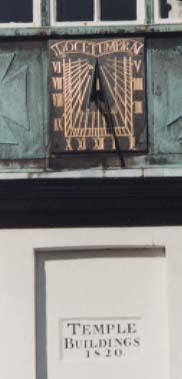 Sundials in Romsey
Street map
Sundials in Romsey
Street map 1 Start in the War Memorial Park. Here is an equatorial sundial in enamelled and stainless steel by Richard Bent. Set up in October 1998 it has the motto For the sun which never sets with dots to mark the half hours. Spend some time looking at the war memorial, Japanese field gun and poems. 2 On 23 The Abbey there is a vertical sundial that declines to the east of south. Built in the 1930ís by a London coppersmith who ĎDrank by day and hammered by night.í it has the motto Docet Umbra (The shadow teaches). 3 The mass dial on the Abbey is not easy to find! It is about 4 metres up on the north face of the southern east buttress. An early case of recycling as the dial is 11th century in appearance, and was probably facing south on the chancel that was demolished in the 13th century. 4 A 10 minute walk takes you to 16 Southampton Road. This wooden dial, made by the owner, is modelled an a German dial. It has the motto Tempus Fugit (Time flies), but donít trust the time on this dial: although visually attractive the gnomon does not point in the correct direction. Sundials between Romsey and Andover At St. Andrewís Church in Timsbury there is a small scratch dial on the south of the south-east angle of the chancel. It is 140 cm from the ground. In the churchyard there is a horizontal dial. In the rose garden at Mottisfont Abbey there is a modern armillary sphere in blue and gold. On St Peter and St Paulís Church at Kingís Somborne there are three scratch dials on the window jambs of the third window from the west. Theses are all inverted, perhaps due to the jambs being swapped over when the church was Ďrestoredí in the 1880s. Stockbridge boasts three dials. There is a horizontal one in the old St. Peterís Churchyard with a possible scratch dial on the north jamb of the west door. On the new St. Peterís there is a possible Saxon dial on the west end of the north aisle window. This is not easy to find, and is probably a recycled stone from the old church. 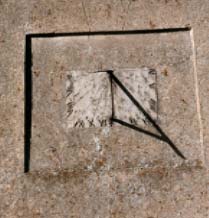 Leckford
has a vertical south facing dial (see picture on left) above the priestís
door. Simple, but effective. Midday is marked by a cross rather than XII,
probably from when the noon line was crossed. There is documentary evidence
that there was a scratch dial on this church: can you find it? Leckford
has a vertical south facing dial (see picture on left) above the priestís
door. Simple, but effective. Midday is marked by a cross rather than XII,
probably from when the noon line was crossed. There is documentary evidence
that there was a scratch dial on this church: can you find it? 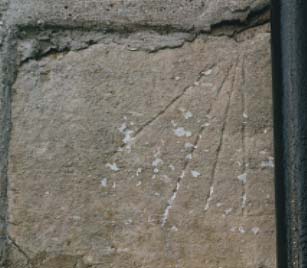 On the west quoins of the nave of All Saintís Church, Upper Clatford are
three dials that show progression in the dialling art. The lower scratch
dial is simple, but the ones above it show a transition to the scientific
dial that evolved during the 17th century. (see picture on right)
On the west quoins of the nave of All Saintís Church, Upper Clatford are
three dials that show progression in the dialling art. The lower scratch
dial is simple, but the ones above it show a transition to the scientific
dial that evolved during the 17th century. (see picture on right) Sundials in Andover Street map Both the sundials at 1 and 2 were designed by William Hawkins Heath (1787-1861). The Heath family played a major part in Andoverís history, being involved in brewing, banking, wine and spirits and coal. 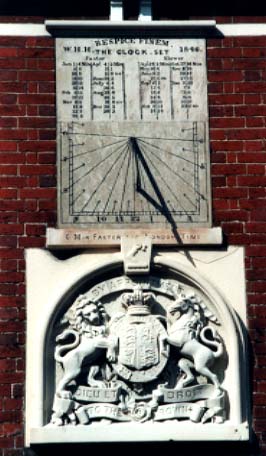 1 Start at 33 London Street. Here is a fine vertical dial that faces slightly
west of south. Made in 1846 it has the equation of time in the form of
a table and the motto Respice Finem (Look to the end).
1 Start at 33 London Street. Here is a fine vertical dial that faces slightly
west of south. Made in 1846 it has the equation of time in the form of
a table and the motto Respice Finem (Look to the end). 2 Walk up London Street a few yards, and round the back of the Savoy Cinema. Here is the other dial by Heath. It also faces a similar direction, slightly the worse for wear. It was originally on Savoy House which was pulled down in 1938 for the cinema to be built. Ut Umbra sic Vita Fugit (As a shadow so doth life fly). 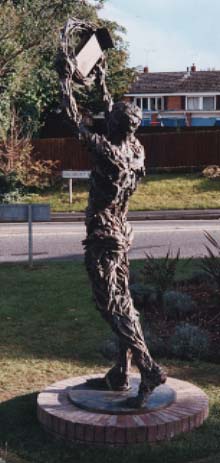 3 Walking Man, Andoverís new work of art was designed and made by Claire
Norrington, a local artist. The east/west sundials were calculated by
Peter Ransom, a mathematics teacher. On the site of Andoverís floral clock
Walking Man watches over Andover with time for everyone. The sundials
are longitude adjusted and show both British Summer Time and Greenwich
Mean Time.
3 Walking Man, Andoverís new work of art was designed and made by Claire
Norrington, a local artist. The east/west sundials were calculated by
Peter Ransom, a mathematics teacher. On the site of Andoverís floral clock
Walking Man watches over Andover with time for everyone. The sundials
are longitude adjusted and show both British Summer Time and Greenwich
Mean Time.
Additinal notes
|